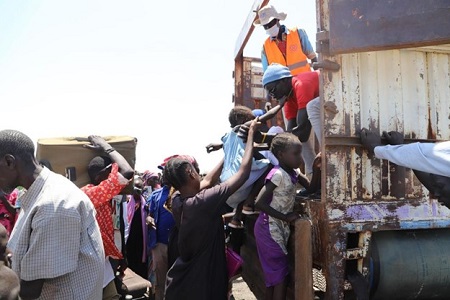Geneva/Port Sudan—A staggering 10.7 million people are now displaced by conflicts in Sudan, nine million inside the country according to new data from the International Organization for Migration (IOM). The Organisation is calling for concerted international efforts to urgently scale up humanitarian response to the world’s largest displacement.
Of the 10.7 million people displaced, 1.7 million have fled the violence to neighbouring countries, the vast majority (62 per cent) being Sudanese. Chad hosts the majority of arrivals at 37 per cent, with South Sudan at 30 per cent and Egypt at 24 per cent while Ethiopia, Libya and the Central African Republic host the remainder. This is creating additional humanitarian needs in a region that is already in deep crisis.
"As of today, one in every eight internally displaced persons in the world is in Sudan. " said Amy Pope, IOM Director General. "Their needs are overwhelming: dire shortages of food, shelter, healthcare, and sanitation, all combine to place them at heightened risk of disease, malnutrition, and violence. Yet the humanitarian response so far is insufficient to meet the dire needs. We cannot turn our backs on the millions of people in need of support.”
Armed clashes over the past nine months have uprooted over six million people, adding to the three million people already displaced within Sudan. The new numbers underscore the urgent need for intensified humanitarian efforts and global attention to address what is now the largest displacement crisis in the world.
Since the crisis began, IOM has been responding to the mounting humanitarian needs inside and outside Sudan, even though many of our staff were directly affected and displaced themselves. IOM is committed to address these most urgent needs and is expanding its response with a newly launched Crisis Response Plan for Sudan appealing for USD 168 million.
The conflict in Sudan continued to have a profound impact on ordinary people. Critical infrastructure, including healthcare facilities, schools, roads, and utilities like power and water sources, along with telecommunications assets, has been destroyed.
This devastation has drastically limited access to basic essentials and life-saving services. Disease outbreaks, hunger, and malnutrition are an ever-present threat. Furthermore, the chaos has heightened vulnerability to sexual and gender-based violence, putting women and girls at increased risk.
To date, IOM has reached nearly 1.2 million people in Sudan and neighbouring countries, with life-saving aid, serving over 650,000 people in Sudan alone. The assistance includes essential protection and health care services, emergency shelter and relief items, cash-based support, provision of clean water and hygiene kits, and critical onward transportation. The latter has allowed nearly 150,000 people to reach safe locations in neighbouring countries where they can access humanitarian services in safe and dignified conditions.
Notes to Editors:
IOM’s Global Crisis Response Platform provides an overview of IOM’s plans and funding requirements to respond to the evolving needs and aspirations of those impacted by, or at risk of, crisis and displacement in 2023 and beyond. The Platform is regularly updated as crises evolve, and new situations emerge.
Download the IOM Sudan Crisis Response Plan 2024-2025 here.
Read more on the latest displacement figures here
***
For more information, please contact:
In Port Sudan: Lisa George, Email: lgeorge@iom.int
In Cairo: Tamim Elyan, Email telyan@iom.int
In Geneva: Kennedy Okoth, Email kokoth@iom.int
Photo: Displaced persons from Sudan arriving in South Sudan. Source: Kenneth Okoth/IOM.
| Themes |
| • Destruction of habitat • Disaster mitigation • Displaced • Displacement • National • Refugees • Regional • UN system |














